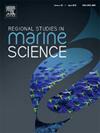Assessment of metal accumulations and ecological risks in sediments around tuna farming in the eastern Aegean Sea
IF 2.1
4区 环境科学与生态学
Q3 ECOLOGY
引用次数: 0
Abstract
Tuna farming has been conducted since 2002 at the sampling site located in the Eastern Aegean Sea. The long-term continuation of this activity in the region has raised concerns regarding its impact on the marine environment, particularly sediment quality. The present study investigated the accumulation of metals, total organic carbon (TOC), phosphorus, and sulfur in sediments influenced by tuna farming and changes in sediment quality using various pollution indices. The highest sulfur concentration (0.19 %) was recorded at the cage stations, indicating significant organic enrichment. The analysis revealed that the average metal concentrations followed the decreasing order of Mn > Cr > Ni > As > Co > Mo > Hg > Cd. It was observed that the concentrations of molybdate, manganese, cadmium, and mercury in the area surrounding the cages were approximately 10 % higher than those in the reference stations. The evaluation of metal analyses in the sediments indicated that farming activities increased Cd, Mn, Hg, and Mo levels at the cage stations. However, none of these metals (except As) exceeded the shale value reference levels. Although cadmium exhibited the highest concentration at the cage station according to the EF and Cf indices, the sediment was classified as having low contamination based on the Cf index. Given the relatively high background concentrations of cadmium and arsenic in the sediment and enrichment from farming-related wastes (such as bait fish and chemicals used in ship maintenance), the fish farming area can be characterized as moderately ecologically risky. While the metal levels in the sediment at the tuna farming site in the Gerence region have yet to reach critical thresholds, continuous monitoring of metals such as arsenic and cadmium in the sediment is essential to ensure the sustainability of farming activities.
求助全文
约1分钟内获得全文
求助全文
来源期刊

Regional Studies in Marine Science
Agricultural and Biological Sciences-Ecology, Evolution, Behavior and Systematics
CiteScore
3.90
自引率
4.80%
发文量
336
审稿时长
69 days
期刊介绍:
REGIONAL STUDIES IN MARINE SCIENCE will publish scientifically sound papers on regional aspects of maritime and marine resources in estuaries, coastal zones, continental shelf, the seas and oceans.
 求助内容:
求助内容: 应助结果提醒方式:
应助结果提醒方式:


